
The 2006–07 South-West Indian Ocean cyclone season featured the second-most intense tropical cyclones for a season in the tropical cyclone basin, only behind the 2018–19 season. The basin contains the waters of the Indian Ocean south of the equator and west of 90°E. Météo-France's meteorological office in Réunion (MFR), the official Regional Specialized Meteorological Center for the South-West Indian Ocean, tracked 15 tropical disturbances, of which eleven attained gale-force winds. The season began in October 2006 with a short-lived tropical disturbance, followed by Anita in November, which was the first named storm of the season. Cyclone Bondo was the first of six intense tropical cyclones, which took a rare track through the southern Seychelles before making landfall on northwest Madagascar, killing 11 people. Severe Tropical Storm Clovis lasted from December 2006 to January 2007; it struck eastern Madagascar, killing four people.

The 2002–03 South-West Indian Ocean cyclone season was one of the longest lasting and the third-most active season in the South-West Indian Ocean. Storms during the season impacted the Mascarene Islands, Seychelles, Madagascar, and countries in south-eastern Africa. The season began early when an unnamed tropical storm struck Seychelles in September, becoming the most damaging storm there in 50 years. The next system, Atang, was the first named storm of the season, but was only a tropical depression; it was named due to the threat to an outer island of Mauritius. Atang later struck Tanzania in a climatologically unusual area in November, resulting in unconfirmed deaths of fishermen. The first named storm to reach tropical storm intensity was Boura, which brushed the Mascarene Islands with gusty winds and rainfall. In December, Cyclone Crystal threatened to strike Mauritius but instead veered eastward, and later, Tropical Storm Delfina lasted from late December through early January 2003. Delfina damaged or destroyed thousands of houses in Mozambique and Malawi, killing 54 people.
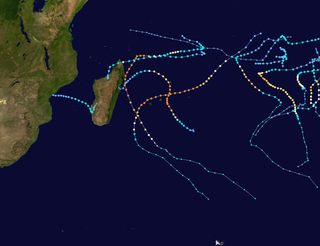
The 2001–02 South-West Indian Ocean cyclone season had the earliest named storm since 1992. Many storms formed in the north-east portion of the basin, and several more originated around Australia. The basin is defined as the waters of the Indian Ocean west of longitude 90°E to the coast of Africa and south of the equator. Eleven tropical storms formed, compared to an average of nine. Tropical systems were present during 73 days, which was significantly higher than the average of 58 for this basin.

Tropical Cyclone Elita was an unusual tropical cyclone that made landfall on Madagascar three times. The fifth named storm of the 2003–04 South-West Indian Ocean cyclone season, Elita developed in the Mozambique Channel on January 24, 2004. It strengthened to tropical cyclone status before striking northwestern Madagascar on January 28; it was the first storm to strike western Madagascar at that intensity since Cyclone Cynthia in 1991. Elita weakened to tropical depression status while crossing the island, and after exiting into the southwest Indian Ocean, it turned to the west and moved ashore in eastern Madagascar on January 31. After once again crossing the island, the cyclone reached the Mozambique Channel and re-intensified. Elita turned to the southeast to make its final landfall on February 3 along southwestern Madagascar. Two days later, it underwent an extratropical transition; subsequently, the remnant system moved erratically before dissipating on February 13.
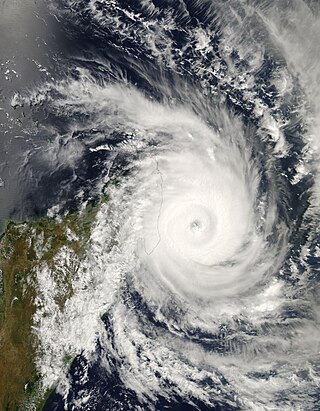
Intense Tropical Cyclone Indlala was a powerful tropical cyclone that struck northeastern Madagascar in March 2007. The ninth named storm and fifth intense tropical cyclone of the 2006–07 South-West Indian Ocean cyclone season, Indlala developed on 3 March 2007 southwest of the Chagos archipelago in the central Indian Ocean. Initially a tropical disturbance, Indlala moved generally westward in its formative stages, attaining tropical cyclone status on 13 March. A day later, the Météo-France office on Réunion (MFR) estimated peak 10–minute sustained winds of 175 km/h (110 mph), although the American-based Joint Typhoon Warning Center estimated stronger 1–minute winds of 220 km/h (135 mph). Early on 15 March, the cyclone made landfall in northeastern Madagascar on the Masoala Peninsula near Antalaha, still at its peak intensity according to the MFR. Indlala rapidly weakened over land and turned southward, eventually re-emerging into the Indian Ocean on 18 March; it was last noted by the MFR on 19 March.

Intense Tropical Cyclone Gamede was among the wettest tropical cyclones on record, dropping more than 5.5 m (18 ft) of rain in a nine-day period on Réunion island in the southwest Indian Ocean. The seventh named storm of the 2006–07 South-West Indian Ocean cyclone season, Gamede formed south of Diego Garcia on February 19 as a tropical disturbance. It tracked generally westward and steadily intensified, reaching tropical cyclone status on February 23. For two days, Gamede stalled northwest of the Mascarene Islands as an intense tropical cyclone, during which it reached 10 minute maximum sustained winds of winds of 165 km/h (105 mph), according to the Météo-France meteorological office in Réunion (MFR). The American-based Joint Typhoon Warning Center (JTWC) estimated peak 1 minute winds of 195 km/h (120 mph), equivalent to a Category 3 on the Saffir–Simpson scale. For four days, Gamede remained within 400 km (250 mi) of Réunion before accelerating southward. On March 2, Gamede transitioned into an extratropical cyclone to the southeast of Madagascar. The MFR tracked the storm for four more days.

The 2008–09 South-West Indian Ocean cyclone season was a slightly above average event in tropical cyclone formation. It began on November 15, 2008, and officially ended on April 30, 2009, with the exception for Mauritius and the Seychelles, for which it ended on May 15, 2009. These dates conventionally delimit the period of each year when most tropical cyclones form in the basin, which is west of 90°E and south of the Equator. Tropical cyclones in this basin were monitored by the Regional Specialised Meteorological Centre in Réunion.

Intense Tropical Cyclone Fanele was the first tropical cyclone to strike western Madagascar since Cyclone Fame one year prior. It formed on January 18, 2009 in the Mozambique Channel, and rapidly organized as it remained nearly stationary. Fanele ultimately turned toward the southwest Madagascar coastline, reaching peak winds of 185 km/h (115 mph), according to the Réunion Météo-France office (MFR). It weakened before moving ashore in Menabe Region southwest of Morondava, and rapidly weakened over land. Fanele briefly re-intensified after reaching open waters, only to become an extratropical cyclone by January 23.
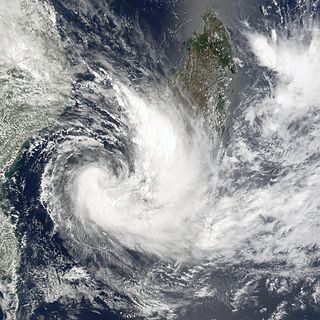
Severe Tropical Storm Cyprien was a short-lived tropical cyclone that caused minor damage in Madagascar. Forming on December 30, 2001, Cyprien quickly strengthened in a slightly favorable environment. By January 2, the storm attained its peak intensity with winds of 100 km/h (65 mph) according to Météo-France and 95 km/h (60 mph) according to the Joint Typhoon Warning Center. Later that day the storm made landfall in Morombe, at a weaker intensity, and dissipated early on January 3. Throughout the affected areas, Cyprien destroyed 957 structures, leaving 1.16 billion Malagasy franc in damages. No fatalities were reported; however two people were listed as missing.

The 1993–94 South-West Indian Ocean cyclone season was the most active season in the basin since the start of reliable satellite coverage in 1967, until the record was surpassed 25 years later in the 2018–19 South-West Indian Ocean cyclone season. Activity lasted from mid-November, when Moderate Tropical Storm Alexina formed, until mid-April, when Tropical Cyclone Odille became extratropical. Four tropical cyclones – Daisy, Geralda, Litanne, and Nadia – struck eastern Madagascar, of which Geralda was the costliest and deadliest. With gusts as strong as 350 km/h (215 mph) accompanied by heavy rainfall, Geralda destroyed more than 40,000 homes and left 356,000 people homeless. Geralda killed 231 people and caused more than $10 million in damage. Cyclone Nadia was the second deadliest cyclone, having killed 12 people in northern Madagascar and later severely damaging portions of northeastern Mozambique, killing about 240 people and leaving $20 million in damage in the latter country. In February, Cyclone Hollanda struck Mauritius near peak intensity, causing $135 million in damage and two deaths.

Very Intense Tropical Cyclone Hary was the strongest tropical cyclone in the 2001–02 South-West Indian Ocean cyclone season. Developing on March 5 from the monsoon trough, the storm initially moved generally to the west and gradually intensified. With favorable conditions, Hary quickly intensified on March 7, developing an eye and well-defined outflow. After reaching an initial peak, the cyclone briefly weakened due to an eyewall replacement cycle, by which time the storm turned southwestward toward Madagascar. Hary re-intensified and attained peak winds of 220 km/h (140 mph) on March 10 just offshore eastern Madagascar, which made it the first very intense tropical cyclone since 2000.
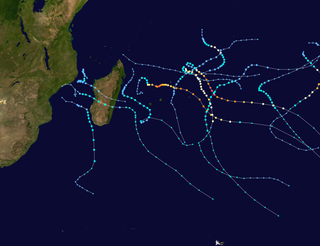
The 2014–15 South-West Indian Ocean cyclone season was an above average event in tropical cyclone formation. It began on November 15, 2014, and ended on April 30, 2015, with the exception for Mauritius and the Seychelles, for which it ended on May 15, 2015. These dates conventionally delimit the period of each year when most tropical and subtropical cyclones form in the basin, which is west of 90°E and south of the Equator. Tropical and subtropical cyclones in this basin are monitored by the Regional Specialised Meteorological Centre in Réunion.

Tropical Cyclone Kesiny was the first recorded tropical cyclone – the equivalent of a minimal hurricane – to make landfall in the month of May in the south-west Indian Ocean. The final named storm of the busy 2001–02 South-West Indian Ocean cyclone season, Kesiny formed on May 2 from a trough near the equator. Its formation was the result of an increase in the Madden–Julian oscillation, which also contributed to a twin storm in the north Indian Ocean that hit Oman, and another set of storms in northeast and southeast Indian Ocean. Kesiny initially moved to the southeast, but later turned to the southwest due to a strengthening ridge. On May 6, it intensified into a tropical cyclone, but later weakened and was not expected to re-strengthen. However, Kesiny developed an eye and re-intensified into a tropical cyclone on May 9, reaching peak winds of 130 km/h (81 mph) before striking Madagascar about 60 km (37 mi) southeast of Antsiranana. It weakened while crossing the country, and after turning to the south it struck the country again before dissipating on May 11.

Tropical Cyclone Manou was a relatively rare May tropical cyclone that affected southeastern Madagascar. The final named storm of the 2002–03 South-West Indian Ocean cyclone season, Manou formed on May 2 to the southwest of Diego Garcia. It moved generally to the southwest for much of its duration, steered by a ridge to the southeast. Manou affected Saint Brandon and Mauritius with gusty winds. After an initial strengthening phase, the storm weakened but later re-intensified as it approached Madagascar. Manou developed a well-defined eye and reached peak winds only 19 km (12 mi) from the eastern Madagascar coastline. For about 12 hours, the cyclone stalled before turning to the south and weakening. Manou became extratropical on May 10 and dissipated three days later.
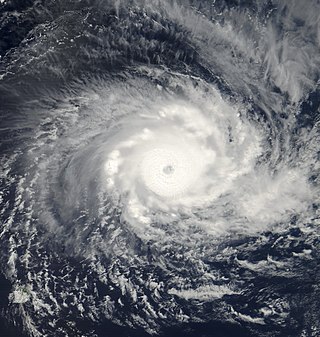
Very Intense Tropical Cyclone Hudah was a powerful and destructive tropical cyclone that affected Southeast Africa in April 2000. It was the last in a series of three cyclones that impacted Madagascar during the year. Hudah first developed as a disturbance embedded within the monsoon trough on 22 March, within the Australian region cyclone basin. Moving westward as the result of a strong subtropical ridge to its south, the storm quickly intensified, and reached Category 2 cyclone intensity on 25 March before entering the Southwest Indian cyclone basin. For various reasons that remain unknown, the cyclone was only designated a name by the time it had crossed into the area of responsibility of the Regional Specialized Meteorological Center in Réunion. Nonetheless, Météo-France (MFR) assigned the name Hudah to the cyclone. An eye formed, and the storm intensified into a tropical cyclone on 27 March well to the southeast of Diego Garcia. On 1 April, the MFR upgraded it to a very intense tropical cyclone, estimating peak 10-minute winds of 225 km/h (140 mph). By contrast, the Joint Typhoon Warning Center (JTWC) estimated 1-minute winds of 235 km/h (146 mph). At this time, the MFR estimated the pressure to have been 905 hPa (mbar), making Hudah the most intense tropical cyclone worldwide in 2000. Cyclone Hudah maintained peak winds until making landfall just southeast of Antalaha, Madagascar on 2 April. It weakened greatly over land, but re-attained tropical cyclone status on 5 April after moving over the Mozambique Channel. Hudah reached 10-minute winds of 160 km/h (99 mph) by the time it made landfall on Mozambique near Pebane, Mozambique, on 8 April, and dissipated by the next day.

Tropical Cyclone Gretelle was a deadly storm that struck southeastern Madagascar in January 1997. The seventh named storm of the 1996–97 South-West Indian Ocean cyclone season, Gretelle developed within the Intertropical Convergence Zone on 19 January, and gradually intensified while moving southwestward. On 22 January, the storm intensified to tropical cyclone status while passing northwest of Réunion; there, Gretelle produced strong wind gusts and heavy rainfall in mountainous regions. Subsequently, the cyclone strengthened to reach peak 10-minute sustained winds of 140 km/h (85 mph). On 24 January, Gretelle made landfall near Farafangana, the first in the region in 41 years. The cyclone weakened while crossing Madagascar, but restrengthened slightly in the Mozambique Channel. Gretelle meandered off the coast of Mozambique, bringing gusty winds that downed trees, but caused little damage in the country. An approaching trough turned the cyclone to the southeast, and Gretelle dissipated on 31 January to the south-southwest of Madagascar.

Tropical Cyclone Alibera was the third longest-lasting tropical cyclone on record in the south-west Indian Ocean, with a duration of 22 days. It formed on December 16, 1989, well to the northeast of Madagascar. For several days, it meandered southwestward while gradually intensifying. On December 20, Alibera intensified to tropical cyclone status with 10‑minute maximum sustained winds of 120 km/h (75 mph), or the equivalent of a minimal hurricane. That day, the Météo-France office in Réunion (MFR) estimated 10‑minute winds of 140 km/h (87 mph), while the Joint Typhoon Warning Center (JTWC), an unofficial warning agency for the region, estimated peak 1‑minute winds of 250 km/h (160 mph). After drifting erratically for several days, the storm began a steady southwest motion on December 29 as a greatly weakened system. On January 1, Alibera struck southeastern Madagascar near Mananjary, having re-intensified to just below tropical cyclone status. It weakened over land but again restrengthened upon reaching open waters on January 3. The storm turned to the southeast, then to the southwest, and finally back to the southeast, dissipating on January 5.

Severe Tropical Storm Chedza was a deadly tropical cyclone that struck Madagascar in January 2015. It formed from the Intertropical Convergence Zone and moved over Mozambique, After moving open waters, the system began organizing on January 14, becoming Tropical Storm Chedza two days later. It quickly intensified over the Mozambique Channel due to warm waters and favorable conditions, and the storm attained peak 10 minute sustained winds of 100 km/h (60 mph) on January 16. That day, Chedza moved ashore western Madagascar between Belo sur Mer and Morondava, and it quickly crossed the island while weakening. The storm briefly re-intensified, passing southwest of Réunion before turning to the southeast. Chedza became extratropical on January 19, and was last noted two days later.

Tropical Cyclone Honorinina was a powerful tropical cyclone that struck eastern Madagascar in March 1986. The eighth named storm of the season, Honorinina formed on 9 March to the south of Diego Garcia. It moved generally to the west-southwest due to a ridge to the south, gradually intensifying. On 12 March, the Météo France office in Réunion (MFR) upgraded Honorinina to tropical cyclone status, which is the equivalent of a minimal hurricane. On the next day, the cyclone attained maximum sustained winds of 150 km/h (93 mph) while in the vicinity of Tromelin Island. Honorinina weakened subsequently before making landfall about 40 km (25 mi) north of Toamasina, Madagascar with winds of 135 km/h (84 mph). The storm weakened further over land, moving southwestward across the country. It emerged into the Mozambique Channel and became extratropical on 18 March. Honorinina then turned to the southeast, dissipating on 23 March.
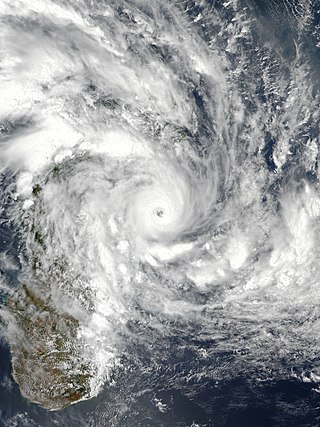
Tropical Cyclone Ava was a strong tropical cyclone that brought devastating impacts to parts of eastern Madagascar in January 2018. The first tropical depression, first named storm, and first tropical cyclone of the 2017–18 South-West Indian Ocean cyclone season, Ava formed as a weak area of disturbed weather well northeast of St. Brandon on December 30. Monitored by Météo-France La Réunion (MFR), the disturbance drifted southwest, before intensifying to a moderate tropical storm on January 2. Ava drifted south afterwards with little change in strength; then among favorable conditions near the coast of Madagascar Ava rapidly intensified to tropical cyclone intensity by early on January 5 shortly before making landfall in eastern Madagascar. After landfall, Ava pummeled the region with rainfall and flooding as it weakens into a moderate tropical storm. Ava exited the landmass on January 7 and became post-tropical southeast of southern Madagascar on January 8, slowly drifting southwards as a vigorous low before dissipating a day later.






















